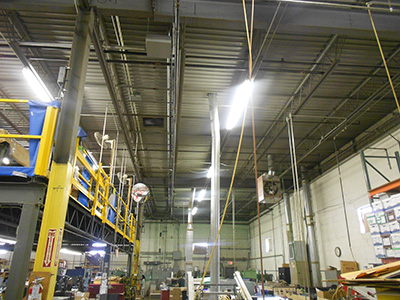Energy-Efficient Lighting in Chicago
The shift towards sustainability and environmental conservation is crucial in today’s world. One essential aspect of this movement is energy-efficient lighting, beneficial not only for the environment but also for businesses’ bottom line. This comprehensive guide is tailored for businesses in Chicago, IL, and surrounding suburbs looking to learn about and switch to energy-efficient lighting.
Introduction to Energy-Efficient Lighting
Energy-efficient lighting involves light bulbs and fixtures that consume less energy than traditional incandescent and halogen lights. The most common types include Light Emitting Diodes (LEDs), Compact Fluorescent Lights (CFLs), and halogen incandescents. These options consume less energy, have a longer lifespan, and lead to significant cost savings for businesses.
The Importance of Energy-Efficient Lighting in Chicago
Chicago, one of the largest and most populous cities in the United States, has a significant environmental impact. The city has set ambitious sustainability goals, including a commitment to 100% renewable energy by 2035. Switching to energy-efficient lighting is a cost-effective way for businesses in Chicago to contribute to these goals and reduce their carbon footprint.
Additionally, energy costs in Chicago and surrounding areas are relatively high, and businesses can save considerably on their energy bills by switching to energy-efficient lighting. The climate in Chicago, characterized by hot summers and cold winters, makes optimizing energy consumption even more critical.
Types of Energy-Efficient Lighting
Several energy-efficient lighting options are available, each with its advantages and disadvantages.
- LED (Light Emitting Diodes): LEDs are the most energy-efficient and long-lasting type of lighting available. They use up to 90% less energy than traditional incandescent bulbs and can last up to 25 times longer. LEDs are available in a wide range of colors and brightness levels, suitable for various applications.
- CFL (Compact Fluorescent Lights): CFLs are another energy-efficient lighting option. They use about 70-90% less energy than traditional incandescent bulbs and can last up to 10 times longer. However, they contain a small amount of mercury, which complicates their disposal.
- Halogen Incandescents: These are a more energy-efficient version of traditional incandescent bulbs. They use about 25-30% less energy and can last up to three times longer. However, they are not as energy-efficient as LEDs or CFLs.
Costs and Savings
While the initial cost of energy-efficient lighting can be higher than traditional lighting, the long-term savings make it a worthwhile investment. For example, an LED bulb may cost more upfront but can save a business hundreds of dollars in energy savings per year! Additionally, the longer lifespan of energy-efficient bulbs means less frequent replacements, leading to further cost savings.
Incentives and Rebates
The city of Chicago, surrounding suburbs, and the state of Illinois offer various incentives and rebates for businesses that switch to energy-efficient lighting. YESCO Chicago is an approved member of the ComEd Energy Efficiency Program which provides incentives for businesses in Chicago and surrounding areas that install energy-efficient lighting and lighting controls. Additionally, from time to time the Illinois Department of Commerce and Economic Opportunity offers grants and incentives for energy efficiency improvements.
Installation and Maintenance
Installing energy-efficient lighting may vary depending on the lighting type and the business’s specific needs. It is recommended to work with a professional lighting contractor, like YESCO Chicago who provide and specialize in energy-efficient lighting solutions. YESCO Chicago can provide a comprehensive lighting audit, design a customized lighting plan, and ensure proper installation.
Maintenance of energy-efficient lighting is generally straightforward. LED and CFL bulbs have a much longer lifespan than traditional incandescent bulbs, requiring less frequent replacements. However, it is essential to regularly check the lighting fixtures and replace any bulbs that have reached the end of their lifespan.
Customized Solutions
Every business is unique, and there is no one-size-fits-all solution for energy-efficient lighting. YESCO Chicago, a professional lighting provider, can design a customized lighting plan that considers the business’s specific needs, such as the space size and layout, the activities conducted, and the desired brightness level.
Legal and Compliance Requirements
Businesses in Chicago and surrounding suburbs must be aware of the legal and compliance requirements related to energy-efficient lighting. The city of Chicago has specific building codes and regulations that need to be followed. Additionally, the state of Illinois has energy efficiency standards that businesses must comply with.
Environmental Impact
Switching to energy-efficient lighting is one of the easiest ways for a business to reduce its environmental impact. It leads to a significant reduction in energy consumption, reducing the business’s carbon footprint. Additionally, energy-efficient lighting contributes to better indoor air quality by reducing the heat emitted by the lighting fixtures.
Conclusion and Next Steps
Switching to energy-efficient lighting is a smart move for businesses in Chicago, and surrounding suburbs. It leads to significant cost savings, contributes to the city’s sustainability goals, and reduces the business’s environmental impact. It is recommended to work with YESCO Chicago, a professional lighting provider that can design a customized lighting plan, provide installation and maintenance services, and help navigate legal and compliance requirements.
By switching to energy-efficient lighting, businesses in Chicago can contribute to a brighter and more sustainable future for the city.
YESCO Chicago is an authorized ComEd® Energy Efficiency Service Provider.

